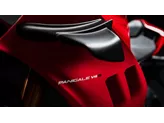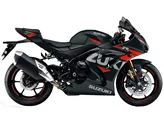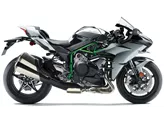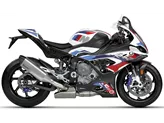Suzuki GSX-R 1000 2015 vs. BMW S 1000 RR 2019

Suzuki GSX-R 1000 2015

BMW S 1000 RR 2019
Overview - Suzuki GSX-R 1000 2015 vs BMW S 1000 RR 2019
The Suzuki GSX-R 1000 model year 2015 and the BMW S 1000 RR model year 2019 are both high-performance supersport motorcycles that offer impressive specifications and features. However, there are notable differences between the two models.
Starting with the engine and drive train, both motorcycles have an inline 4-cylinder engine with a displacement of 999cc. The Suzuki GSX-R 1000 produces 185 HP of power and 116.7 Nm of torque, while the BMW S 1000 RR delivers a higher power output of 207 HP and 113 Nm of torque. The Suzuki has a compression ratio of 12.8, while the BMW has a higher compression ratio of 13.3. Both motorcycles have DOHC valves and utilize an in-line engine type.
In terms of suspension, both motorcycles have adjustable front and rear suspension systems that allow for compression, preload, and rebound adjustments. This allows riders to fine-tune the suspension to their preferences and riding style.

Suzuki GSX-R 1000 2015
When it comes to the chassis, both motorcycles feature an aluminum frame. However, the Suzuki GSX-R 1000 has a twin-spar frame type, while the BMW S 1000 RR has a twin tube, load-bearing engine frame type. Both frames are designed to provide optimal rigidity and handling characteristics.
In terms of braking, both motorcycles feature double disc brakes at the front with radial technology. This ensures powerful and precise braking performance.
In terms of dimensions and weights, the Suzuki GSX-R 1000 has a wheelbase of 1405 mm, a seat height of 810 mm, and a kerb weight of 205 kg (with ABS). On the other hand, the BMW S 1000 RR has a slightly longer wheelbase of 1441 mm, a higher seat height of 824 mm, and a lower kerb weight of 197 kg (with ABS). Both motorcycles have a front tire width of 120 mm and a rear tire width of 190 mm, with a 17-inch diameter for both front and rear tires.
In terms of fuel tank capacity, the Suzuki GSX-R 1000 has a larger capacity of 17.5 liters, while the BMW S 1000 RR has a slightly smaller capacity of 16.5 liters.

BMW S 1000 RR 2019
Moving on to the strengths of each motorcycle, the Suzuki GSX-R 1000 2015 benefits from sophisticated technology and a wealth of experience from years of successful racing. It also offers a wide range of accessories for customization. On the other hand, the BMW S 1000 RR 2019 boasts a very linear power delivery, making it more controllable and faster for most riders. It also has a wide rev range and pleasant dosing, along with a precise DDC (Dynamic Damping Control) system and a top-notch electronics package. The BMW also offers an excellent shift assistant and a sportier seating position. Additionally, the BMW S 1000 RR features high-quality details such as the frame, swingarm, and display, which add to its overall appeal.
As for weaknesses, the Suzuki GSX-R 1000 2015 is considered a greyed model and its electronics are no longer up to date. On the other hand, the BMW S 1000 RR 2019 has lost a certain amount of "thrill" due to its linear power delivery. Some riders may find the menu navigation on the BMW to take some time to get used to.
In conclusion, both the Suzuki GSX-R 1000 2015 and the BMW S 1000 RR 2019 are formidable supersport motorcycles with their own set of strengths and weaknesses. The Suzuki offers a proven track record and a wide range of accessories, while the BMW provides a more controllable power delivery and a superior electronics package. Ultimately, the choice between the two will depend on the rider's preferences and priorities.
Technical Specifications Suzuki GSX-R 1000 2015 compared to BMW S 1000 RR 2019
Pros and Cons in comparison
Pros and Cons in comparison
Suzuki GSX-R 1000 2015

Many victorious years in international motorbike racing have made the GSX-R1000 superbike a legend - and a somewhat grey model. Real innovations or even revolutions are a long time ago, and the last updates were limited to visual upgrades, such as the MotoGP Replica paint scheme. It may look fresh and snappy, but in the segment of racers that have now advanced to technologically advanced and correspondingly expensive hyper-sports bikes, the GSX-R now looks like a slightly greying prototype. It still rides well, fast and harmoniously, you can just tell it's mature - and that's meant in a positive way. Nevertheless, we are already waiting for the next generation.
BMW S 1000 RR 2019

The new 2019 BMW S 1000 RR is a completely new supersports bike. It has become significantly more compact and, above all, lighter. The machine is incredibly easy to control and, compared to the previous model, almost feels like a 600! The seating position and the entire set-up of the machine have become much sportier, but can be brought to the tarmac in a much more user-friendly way thanks to the significantly improved electronics package, the saved weight and, last but not least, the almost linear power delivery of the power unit - bravo! Unfortunately, there is still one downer: if you want to benefit from the innovations to the maximum, you have to put a maximum number of crosses in the dealer's box. In return, however, you can create your own individual BMW!
Price Comparison Avarage Market Price Suzuki GSX-R 1000 vs BMW S 1000 RR
There are a few key differences between a Suzuki GSX-R 1000 2015 and a BMW S 1000 RR 2019. It takes less time to sell a BMW S 1000 RR with 63 days compared to 83 days for the Suzuki GSX-R 1000. Since model year 2005 1000PS.de editors have written 71 reviews for the Suzuki GSX-R 1000 and 135 reviews for the BMW S 1000 RR since model year 2010. The first review for the Suzuki GSX-R 1000 was published on 3/3/2004 and now has more than 7,100 views. This compares to more than 4,000 views for the first review on BMW S 1000 RR published on 4/16/2008.


















